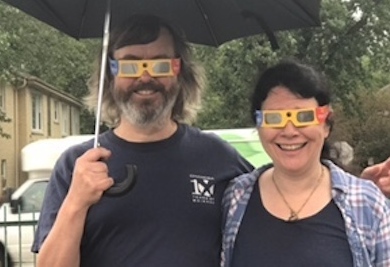Photo: Belmont’s resident astrophysicists, Steven Saar and Andrea Prestwich, ready for Monday’s solar eclipse.
Andrea Prestwich is approaching viewing Monday’s total solar eclipse of two minds. As an astrophysicist at Harvard’s Smithsonian Astrophysical Observatory who explores the vastness of space through an orbital x-ray telescope – the Chandra X-ray Observatory – the coming eclipse is, well, disappointing ordinary.
“The rational part of me is underwhelmed. This whole event is just a shadow, after all!” said Prestwich, who is a member of the Belmont School Committee. “It is nowhere near as significant as, say, the discovery of gravitational waves or cosmic X-ray sources.”
But by Monday afternoon, Prestwich said she’ll revert to her five-year-old self who first discovered an interest in the heavens.
“The kid in me is wildly excited! I get to see the [sun’s] corona with my own eyeballs!”
Monday will be a special day for Prestwich and her husband, Steven Saar, who happens to be the other astrophysicist in the family – working at the Harvard-Smithsonian Center for Astrophysics – as it will be the first time either has witnessed a total solar eclipse.
For Saar, the blotting out of the sun Monday is something akin to his line of research as a member of the Solar and Stellar X-Ray Group, researchers who study solar and stellar atmospheres.
Saar: The day before we will study the local weather carefully, and be prepared to drive a bit to a clearer spot if needed. If we can’t get to one, we will pout a lot, but still, enjoy the natural phenomena that are still visible.








Grammar: “either HAS.’